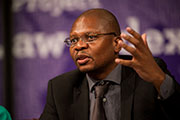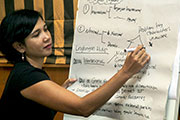Scholars say, the design of a Constitution and its constitution-making process can play an important role in the political and governance transition. Constitution making after conflict is an opportunity to create a common vision of the future of a state and a road map on how to get there. The Constitution can be partly a peace agreement and partly a framework setting up the rules by which the new democracy will operate.
An ideal constitution-making process can accomplish several things. For example, it can drive the transformative process from conflict to peace, seek to transform the society from one that resorts to violence to one that resorts to political means to resolve conflict, and/or shape the governance framework that will regulate access to power and resources—all key reasons for conflict. It must also put in place mechanisms and institutions through which future conflict in the society can be managed without a return to violence. The role of the national actors in making decisions during this process is always crucial.
However, experiences have shown that peace-building accomplished through international intervention alone has had little success in achieving sustainable peace. In February of 2004, Haiti slipped back into chaos and despair, turning ten years of international and Haitian state building efforts to dust. Liberia had to go through its second round of international intervention since returning to conflict in 2004 following UN supervised elections in 1997. There is daily violence in Iraq and ongoing instability in Afghanistan even after several years of the democratization efforts. Kosovo remains under UN administration, with an uncertain future and ongoing undercurrents of conflict. Successes in South Africa and Cambodia, and now in Liberia and Sierra Lone, have set examples for emerging post-conflict nations. But these success stories can hardly be replicated.
Nepal has a different story. The peace process that started in 2005 has been considered more or less concluded, however, without completing the task of framing a new Constitution for the country. Will peace be institutionalized in absence of a Constitution which was a part of the peace deal? In this description, many issues have been raised in the form of questions for seeking responses and sharing comparative experiences from the experts of different countries.
Issues and options:
1. Initiating peace process and settling violent conflict
How negotiations are initiated and settled in agreements with promises to resolve conflicts and institutionalize peace through constitutional designs ?
How did peace agreements and the constitution seek to address these causes and prevent a return to violence in your country?
To what extent can constitutional processes bring an end to violent conflict?
There is always the danger of slipping back into civil war or strife. Can a well-designed constitution help avoid this?
Is it possible to reconcile the short term goals of peace-making/ceasefires with the longer term longer-term requirements of institution building? How?
2. Changing role of actors and institution building
Do institutions need to be built around existing actors (and indeed social reality), or can actors be moulded to ‘fit’ institutional requirements?
How can the satisfaction of the short-run, but deeply felt needs of the perpetrators of the conflict be reconciled with the longer-term requirements of institution building?
Can incentives be made strong enough to encourage civil war actors to transform themselves into constitutional democrats? Does an inclusive and participatory process help foster unity in diversity and build a society tolerant?
How (if at all) should non-state armed actors (warlords) be brought into the peace process and institutional design of the new state? What competing interests do they bring to the table and what incentives might be employed to co-opt them in the process?
How (if at all) should traditional actors and customary practices be brought into the process and/or incorporated into the institutional design of the new state?
Constitutions are largely about institution building which aims to transform the nature of political competition. What kinds of incentives are needed to encourage civil war actors to transform themselves into constitutional democrats?
How does one prevent ‘capture’ of institutions by certain groups?
3. Issues of sequencing and prioritization
Are there certain contexts where a peace agreement is likely to be more or less useful prior to the drafting of a permanent constitution? In what ways did the terms of peace agreements help or hinder long term constitutional design?
Is constitution-making more useful at one stage than another? A what point in a peace process should a permanent constitution be drafted?
Do peace-building efforts help or hinder the negotiation and drafting of a permanent constitution? Should peace-building efforts precede or follow the drafting of a permanent constitution? How should they be prioritized?
4. The role of informal institutions
Constitutional processes are about putting in place formal rules that govern the competition for power. However, institutions also encompass informal constraints, including conventions or norms of behavior which have evolved differently in specific communities. What role can these informal constraints play in the achievement of a ceasefire?
How do informal institutions contribute to the durability of post-conflict settlements?
Can and should constitutional processes account for informal institutions? If so, how?
What role can or should religion play in the constitutional design of the new state? And how can designers ensure religion, if incorporated, plays a galvanizing or stabilizing role?
5. Sharing experiences and learning from others
Are there any western or first-world based constitutional models, or processes, that maybe especially useful and relevant to post-conflict situations in the developing world?
Which elements of western constitutional models are most relevant and easily implemented?
Has the adoption of western models by non-western post-conflict states hindered the development of long-term peace?
How does one embed universally accepted democratic values into post-conflict situations?
6. Plugging the gaps
Western students of constitutionalism place particular emphasis on the following: Bills of rights (especially personal rights and privacy) and the rule of law; electoral systems, and the relation between executives and legislatures. Are there other elements that should be taken into account?
What key elements are omitted here?
What should be added to make the studies and processes more relevant, useful and productive?
7. Next steps

